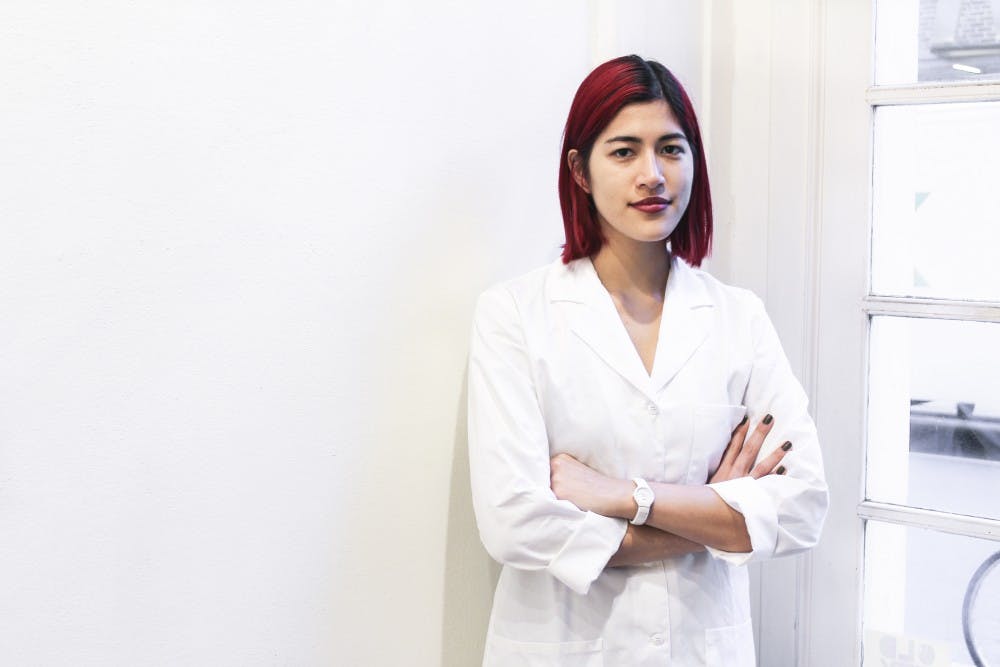In the waiting room of the Healing Touch Integral Wellness Center in Old City, I hold a pen to a diagram of the human body with the instruction to label the site of my emotional pain. I do, and then I continue to answer the rest of the questions on the medical forms I’m filling out. Am I pleased with the number or intimacy of my personal relationships? Do I consume any caffeinated beverages? What was the last work of art to make me cry? Did crying help?
Moments after I submit these forms, a quiet receptionist motions to me and says, “The doctor is ready to see you.”
She leads me through the doors of the waiting room into a large hall lined with benches against walls punctuated by anatomical drawings. Walking through it to the single room at the end has a feeling of heaviness and finality. I’m here without knowing much of what to expect and I’m skeptical of what’s to come and whether whatever does might help me. The receptionist falls back and motions me forward, and as I enter the room I’m greeted warmly by my doctor: Emma Sulkowicz.
"I haven’t done this with anyone yet,” she says, “but if you could just lay on the bed and close your eyes for a minute, that would be great.”
Emma Sulkowicz is an artist. She’s most popularly known for her Mattress Performance (Carry That Weight) (2014–15), which served as her senior thesis as a Visual Arts major at Columbia. For the entirety of her senior year, she carried a mattress with her at all times. The piece garnered both positive and negative criticism and served to address the artist’s own experience with sexual assault and the largely lukewarm response to campus assault in general. Now, two years after her graduation, Emma is installed in Philadelphia with Philadelphia Contemporary as Pseudo–Doctor Sulkowicz.
The office is arranged more like a still life of a clinic than a functioning doctor's office. In one corner, a blooming peace lily sits propped on a platform. Against another wall, a table with a bottle of lotion and a box of tissues. The patient bed is covered with a layer of paper similar to that found in actual medical offices, but it seems more translucent, less substantial. After I lie there in silence for a minute, I straighten up and begin my session. Emma sits across from me holding a pad of yellow paper, already half–full of notes.
The Healing Touch Integral Wellness Center, which is open Friday to Monday from 10 a.m. to 6:30 p.m. until January 29, is an experiment in desire. In setting up and attending a session (which, for students, costs fifteen dollars and thirty for anyone else), one is confronted with questions of want. What do I want to gain from this experience? What do I want to discuss? Of what do I want to be healed? The practice, in this sense, is intensely meditative and reflective. It looks at the relationship between art and life and decentralizes the role of the artist, instead focusing inherently on that of the participant.
In the thirty minutes that follow, Emma and I discuss more than I expected we would. She probes deep into my past and current relationships, my feelings about myself and significant events in my life. Her questions are carefully formed and her comments are incisive, but her frequent pauses make it clear that she’s not really a trained medical professional, and instead someone just recently graduated from college. In a way it feels like going to see a psychic – I made myself vulnerable to her, a stranger, for a full half hour, and absorbed her thoughts and advice and interpretations. When finished, I'm left to piece together the significance of her words. And because she's just a stranger and has no obligation to be strictly professional, the meeting feels strangely like talking with an old friend.
After thanking her and leaving her office, I do feel lighter. Not cured (whatever that might mean), but certainly glad that I had come.
Image: "Doctor" Emma Sulkowicz at The Healing Touch Wellness Center. Photo: Emily Belshaw, 2017

